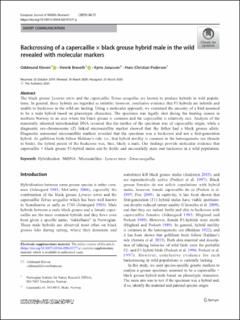| dc.contributor.author | Kleven, Oddmund | |
| dc.contributor.author | Brøseth, Henrik | |
| dc.contributor.author | Jonassen, Kyrre | |
| dc.contributor.author | Pedersen, Hans Christian | |
| dc.date.accessioned | 2020-03-31T12:28:23Z | |
| dc.date.available | 2020-03-31T12:28:23Z | |
| dc.date.issued | 2020 | |
| dc.identifier.issn | 1612-4642 | |
| dc.identifier.uri | https://hdl.handle.net/11250/2649683 | |
| dc.description.abstract | The black grouse Lyrurus tetrix and the capercaillie Tetrao urogallus are known to produce hybrids in wild populations. In general, these hybrids are regarded as infertile; however, conclusive evidence that F1-hybrids are infertile and unable to backcross in the wild are lacking. Using a molecular approach, we examined the ancestry of a bird assumed to be a male hybrid based on phenotypic characters. The specimen was legally shot during the hunting season in northern Norway in an area where the black grouse is common and the capercaillie is relatively rare. Analysis of the maternally inherited mitochondrial DNA revealed that the mother of the specimen was of capercaillie origin, while a diagnostic sex-chromosome (Z) linked microsatellite marker showed that the father had a black grouse allele. Diagnostic autosomal microsatellite markers revealed that the specimen was a backcross and not a first-generation hybrid. As galliform birds follow Haldane’s rule, i.e., that hybrid sterility is common in the heterogametic sex (female in birds), the hybrid parent of the backcross was, thus, likely a male. Our findings provide molecular evidence that capercaillie × black grouse F1-hybrid males can be fertile and successfully mate and backcross in a wild population. | en_US |
| dc.language.iso | eng | en_US |
| dc.rights | An error occurred on the license name. | * |
| dc.subject | Hybridization | en_US |
| dc.subject | MtDNA | en_US |
| dc.subject | Microsatellites | en_US |
| dc.subject | Lyrurustetrix | en_US |
| dc.title | Backcrossing of a capercaillie × black grouse hybrid male in the wild revealed with molecular marker | en_US |
| dc.type | Journal article | en_US |
| dc.description.version | publishedVersion | en_US |
| dc.rights.holder | ©The Author(s) 2020 | en_US |
| dc.subject.nsi | VDP::Matematikk og Naturvitenskap: 400::Zoologiske og botaniske fag: 480 | en_US |
| dc.source.volume | 66 | en_US |
| dc.source.journal | European Journal of Wildlife Research | en_US |
| dc.identifier.doi | 10.1007/s10344-020-01377-y | |
| dc.identifier.cristin | 1804587 | |
